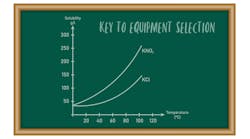Particulate solids can be troublesome to handle at times — but pastes, cakes and slurries can cause your hair to turn grey. While some are pumpable, others require special treatment without changing the overall characteristics of the product. The biggest problems often occur in storage and conveying processes. You should explore two categories of techniques to solve these problems.
[pullquote]
First, consider altering the bulk properties to improve handling. Methods involve paste pre-formation, agglomeration, shear strength reduction, stickiness reduction and manipulation of the particle characteristics. However, altering the product’s bulk properties can pose complications. Often the desired product is the paste or cake, so any modification might reduce its value or usability.
Second, look at equipment selection, design and operation. Most dryers don’t handle lumps very well. Typically, cake from compression filters requires reduction in size before it can be conveyed or fed to a dryer. You must address not only the feeding problems but also the removal of these solids from any intermediate operation or storage. Equipment selection is a much broader topic than altering the bulk properties, so always investigate the latter first.
When altering the bulk properties doesn’t pose insurmountable product quality or performance issues, you have a number of options. Let’s focus on the major changes available:
• Pre-forming pastes using roller or pressure extruders with or without a cutter can create a more-uniform feed or even pellets that dry quicker or don’t stick to the feed zone of calciners or kilns. Pre-formed or extruded material with high strength may allow use of screw or vibratory conveyors for transport.
• Size enlargement improves the handling properties of wet solids because the internal shear strength and wall friction generally decrease as material size increases. Enlargement can reduce caking and lump formation, lessen hazards associated with obnoxious materials and create a better blend that doesn’t separate. Techniques include agglomeration, briquetting and granulation. You can grind the material, once dried, to the desired size.
• Shear strength reduction of a paste or cake can allow pumping at low pressure over long distances of a material that otherwise would require a high-pressure pump, which is limited to only short distances. A high-shear mixer or agitator, either on its own or as part of a feeder, can do the job. This technique suits thixotropic materials as well as material from compression filters because the moisture in the cake can be redistributed to decrease stickiness.
• Partial drying of the surface of a cake can reduce the tendency of the material to stick to the equipment surfaces. In addition to treating the solid, cooling of equipment surfaces sometimes will lessen adhesion. Companies in the food industry often rely on this approach to improve hygiene along with flowability. Another method is to blend part of the dry material with wet material. For wet cake, a double paddle mixer is common, while for slurry, a high-speed mixer is preferred.
• You can improve the flow curve (shear stress versus shear rate) of pumpable pastes through use of flocculants or dispersants to pare power requirements. Wet grinding of particles to below 5 micron can form a flocculated product that behaves like a coarse material without adding another chemical. Size distribution, shape and concentration all change the viscosity and pumpability. A wide-size-distribution material of rounded, low-aspect ratio particles has a lower viscosity at the same solids’ concentration. Diluting the concentration generally will reduce viscosity — but at an increased cost. However, at very high solids’ concentrations, a small change in concentration can be very effective. Some other methods of creating stabilized slurry involve the use of fine particles to create a denser non-Newtonian suspended medium, and relying on fibers or oils to agglomerate coarse solids.
Slurry, paste and cake processing is both a chemical and physical challenge. Some items required to design these systems include: particle size distribution; fluid viscosity; solids loading; particle shape; stickiness; chemical composition (both of particles and fluid); density (particle and fluid); and extrinsic parameters such as temperature and pressure. Phase-change parameters such as enantiomers and polymorphs along with particle shear properties can complicate a technology’s application. Begin by looking at what bulk properties you can manipulate in your process.



